Essay: Cross-Cultural Management in Global Leadership Context
VerifiedAdded on 2021/05/30
|9
|2737
|140
Essay
AI Summary
This essay delves into the multifaceted issues of global leadership and communication, with a specific focus on cross-cultural management. It reviews relevant literature, highlighting the significance of cross-cultural management in the modern business environment. The essay examines key themes such as organizational behavior, employee psychology, and the impact of cultural differences within organizations. It emphasizes the importance of managers understanding and addressing these differences to foster a productive and harmonious work environment. The discussion encompasses the challenges faced by organizations expanding globally, the role of leadership in navigating cultural complexities, and the evolution of management approaches in response to globalization. The essay explores various leadership styles and approaches, including unicultural, comparative, intercultural, and global approaches, providing insights into how organizations can effectively manage diverse teams and stakeholders to achieve their objectives.
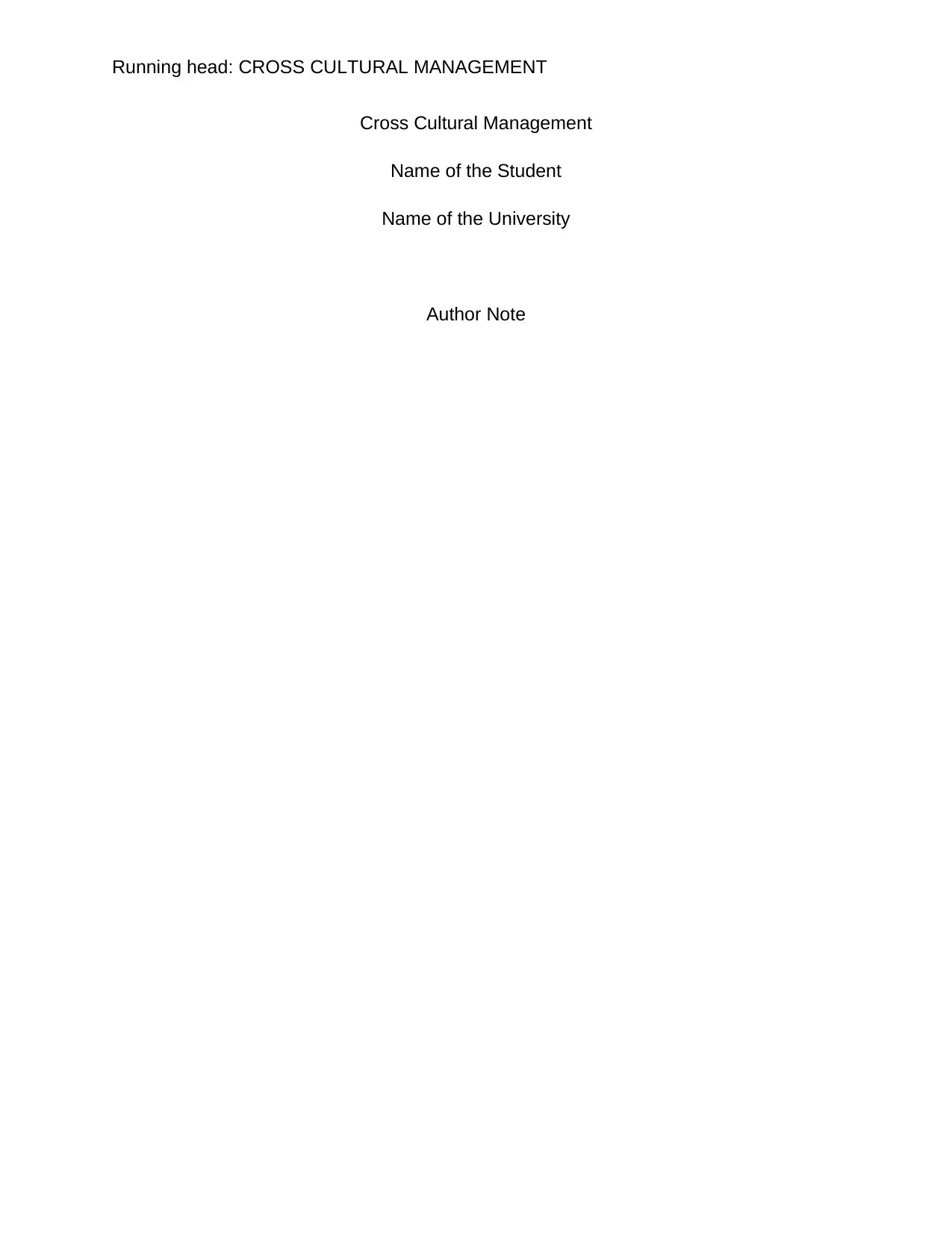
Running head: CROSS CULTURAL MANAGEMENT
Cross Cultural Management
Name of the Student
Name of the University
Author Note
Cross Cultural Management
Name of the Student
Name of the University
Author Note
Paraphrase This Document
Need a fresh take? Get an instant paraphrase of this document with our AI Paraphraser
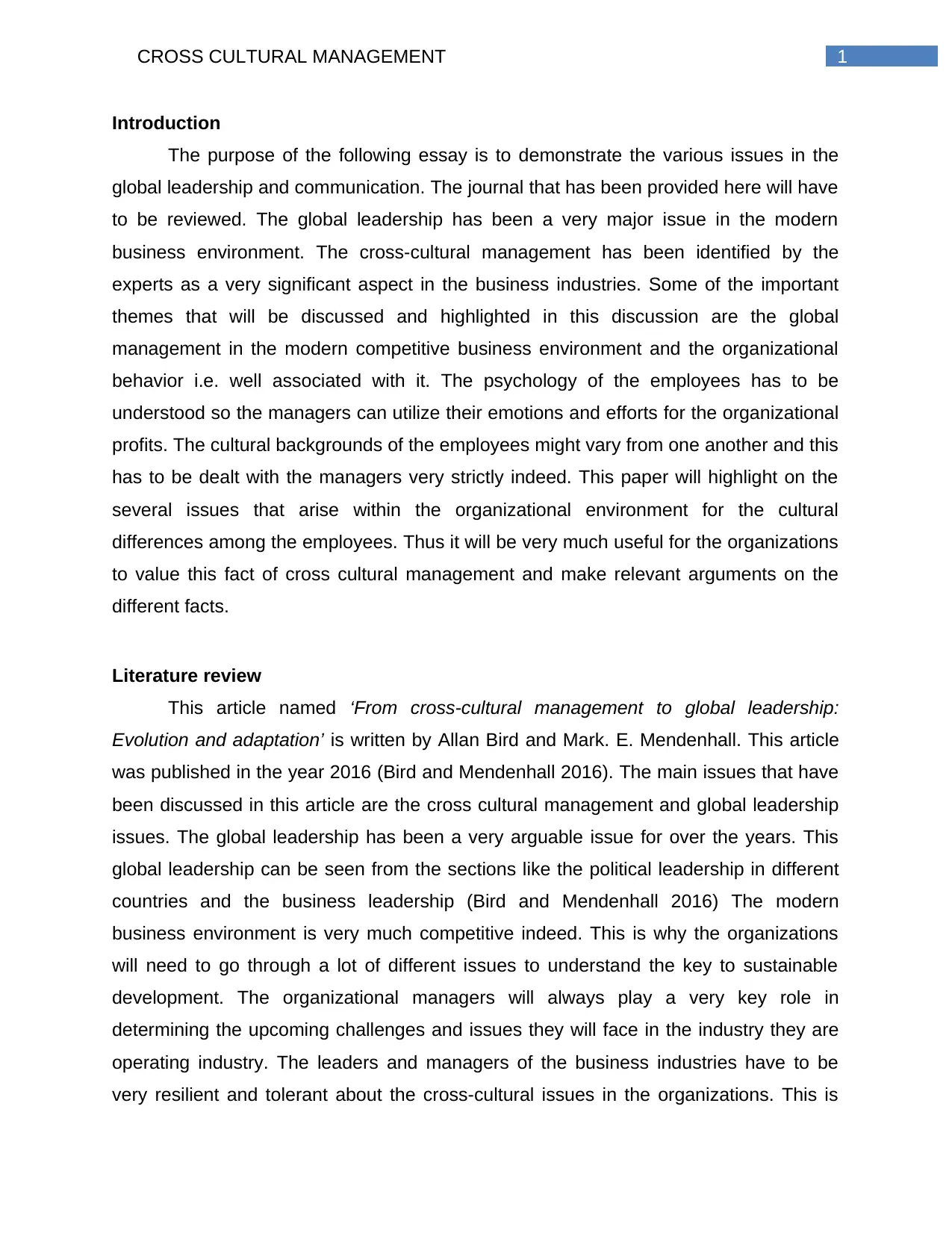
1CROSS CULTURAL MANAGEMENT
Introduction
The purpose of the following essay is to demonstrate the various issues in the
global leadership and communication. The journal that has been provided here will have
to be reviewed. The global leadership has been a very major issue in the modern
business environment. The cross-cultural management has been identified by the
experts as a very significant aspect in the business industries. Some of the important
themes that will be discussed and highlighted in this discussion are the global
management in the modern competitive business environment and the organizational
behavior i.e. well associated with it. The psychology of the employees has to be
understood so the managers can utilize their emotions and efforts for the organizational
profits. The cultural backgrounds of the employees might vary from one another and this
has to be dealt with the managers very strictly indeed. This paper will highlight on the
several issues that arise within the organizational environment for the cultural
differences among the employees. Thus it will be very much useful for the organizations
to value this fact of cross cultural management and make relevant arguments on the
different facts.
Literature review
This article named ‘From cross-cultural management to global leadership:
Evolution and adaptation’ is written by Allan Bird and Mark. E. Mendenhall. This article
was published in the year 2016 (Bird and Mendenhall 2016). The main issues that have
been discussed in this article are the cross cultural management and global leadership
issues. The global leadership has been a very arguable issue for over the years. This
global leadership can be seen from the sections like the political leadership in different
countries and the business leadership (Bird and Mendenhall 2016) The modern
business environment is very much competitive indeed. This is why the organizations
will need to go through a lot of different issues to understand the key to sustainable
development. The organizational managers will always play a very key role in
determining the upcoming challenges and issues they will face in the industry they are
operating industry. The leaders and managers of the business industries have to be
very resilient and tolerant about the cross-cultural issues in the organizations. This is
Introduction
The purpose of the following essay is to demonstrate the various issues in the
global leadership and communication. The journal that has been provided here will have
to be reviewed. The global leadership has been a very major issue in the modern
business environment. The cross-cultural management has been identified by the
experts as a very significant aspect in the business industries. Some of the important
themes that will be discussed and highlighted in this discussion are the global
management in the modern competitive business environment and the organizational
behavior i.e. well associated with it. The psychology of the employees has to be
understood so the managers can utilize their emotions and efforts for the organizational
profits. The cultural backgrounds of the employees might vary from one another and this
has to be dealt with the managers very strictly indeed. This paper will highlight on the
several issues that arise within the organizational environment for the cultural
differences among the employees. Thus it will be very much useful for the organizations
to value this fact of cross cultural management and make relevant arguments on the
different facts.
Literature review
This article named ‘From cross-cultural management to global leadership:
Evolution and adaptation’ is written by Allan Bird and Mark. E. Mendenhall. This article
was published in the year 2016 (Bird and Mendenhall 2016). The main issues that have
been discussed in this article are the cross cultural management and global leadership
issues. The global leadership has been a very arguable issue for over the years. This
global leadership can be seen from the sections like the political leadership in different
countries and the business leadership (Bird and Mendenhall 2016) The modern
business environment is very much competitive indeed. This is why the organizations
will need to go through a lot of different issues to understand the key to sustainable
development. The organizational managers will always play a very key role in
determining the upcoming challenges and issues they will face in the industry they are
operating industry. The leaders and managers of the business industries have to be
very resilient and tolerant about the cross-cultural issues in the organizations. This is
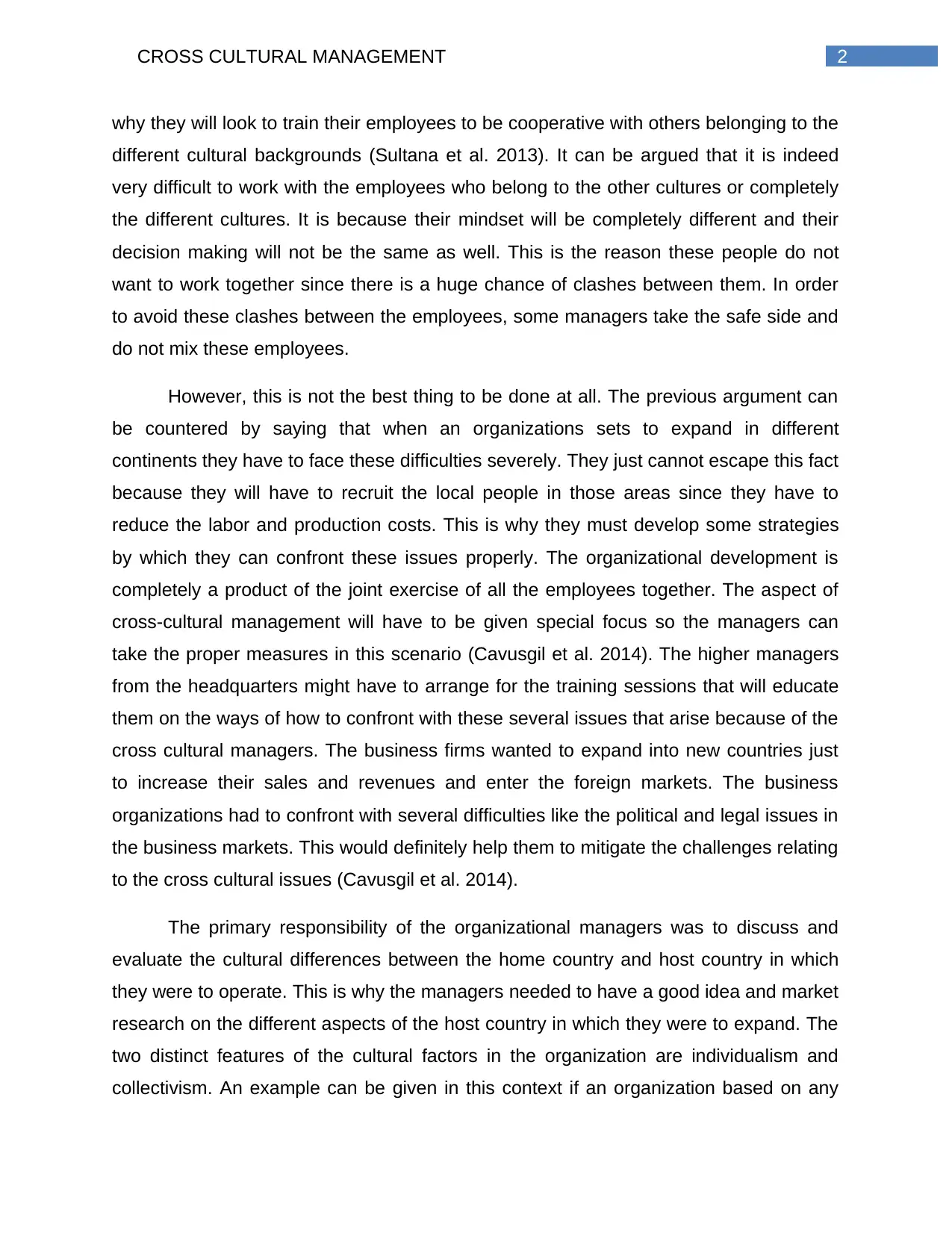
2CROSS CULTURAL MANAGEMENT
why they will look to train their employees to be cooperative with others belonging to the
different cultural backgrounds (Sultana et al. 2013). It can be argued that it is indeed
very difficult to work with the employees who belong to the other cultures or completely
the different cultures. It is because their mindset will be completely different and their
decision making will not be the same as well. This is the reason these people do not
want to work together since there is a huge chance of clashes between them. In order
to avoid these clashes between the employees, some managers take the safe side and
do not mix these employees.
However, this is not the best thing to be done at all. The previous argument can
be countered by saying that when an organizations sets to expand in different
continents they have to face these difficulties severely. They just cannot escape this fact
because they will have to recruit the local people in those areas since they have to
reduce the labor and production costs. This is why they must develop some strategies
by which they can confront these issues properly. The organizational development is
completely a product of the joint exercise of all the employees together. The aspect of
cross-cultural management will have to be given special focus so the managers can
take the proper measures in this scenario (Cavusgil et al. 2014). The higher managers
from the headquarters might have to arrange for the training sessions that will educate
them on the ways of how to confront with these several issues that arise because of the
cross cultural managers. The business firms wanted to expand into new countries just
to increase their sales and revenues and enter the foreign markets. The business
organizations had to confront with several difficulties like the political and legal issues in
the business markets. This would definitely help them to mitigate the challenges relating
to the cross cultural issues (Cavusgil et al. 2014).
The primary responsibility of the organizational managers was to discuss and
evaluate the cultural differences between the home country and host country in which
they were to operate. This is why the managers needed to have a good idea and market
research on the different aspects of the host country in which they were to expand. The
two distinct features of the cultural factors in the organization are individualism and
collectivism. An example can be given in this context if an organization based on any
why they will look to train their employees to be cooperative with others belonging to the
different cultural backgrounds (Sultana et al. 2013). It can be argued that it is indeed
very difficult to work with the employees who belong to the other cultures or completely
the different cultures. It is because their mindset will be completely different and their
decision making will not be the same as well. This is the reason these people do not
want to work together since there is a huge chance of clashes between them. In order
to avoid these clashes between the employees, some managers take the safe side and
do not mix these employees.
However, this is not the best thing to be done at all. The previous argument can
be countered by saying that when an organizations sets to expand in different
continents they have to face these difficulties severely. They just cannot escape this fact
because they will have to recruit the local people in those areas since they have to
reduce the labor and production costs. This is why they must develop some strategies
by which they can confront these issues properly. The organizational development is
completely a product of the joint exercise of all the employees together. The aspect of
cross-cultural management will have to be given special focus so the managers can
take the proper measures in this scenario (Cavusgil et al. 2014). The higher managers
from the headquarters might have to arrange for the training sessions that will educate
them on the ways of how to confront with these several issues that arise because of the
cross cultural managers. The business firms wanted to expand into new countries just
to increase their sales and revenues and enter the foreign markets. The business
organizations had to confront with several difficulties like the political and legal issues in
the business markets. This would definitely help them to mitigate the challenges relating
to the cross cultural issues (Cavusgil et al. 2014).
The primary responsibility of the organizational managers was to discuss and
evaluate the cultural differences between the home country and host country in which
they were to operate. This is why the managers needed to have a good idea and market
research on the different aspects of the host country in which they were to expand. The
two distinct features of the cultural factors in the organization are individualism and
collectivism. An example can be given in this context if an organization based on any
⊘ This is a preview!⊘
Do you want full access?
Subscribe today to unlock all pages.

Trusted by 1+ million students worldwide
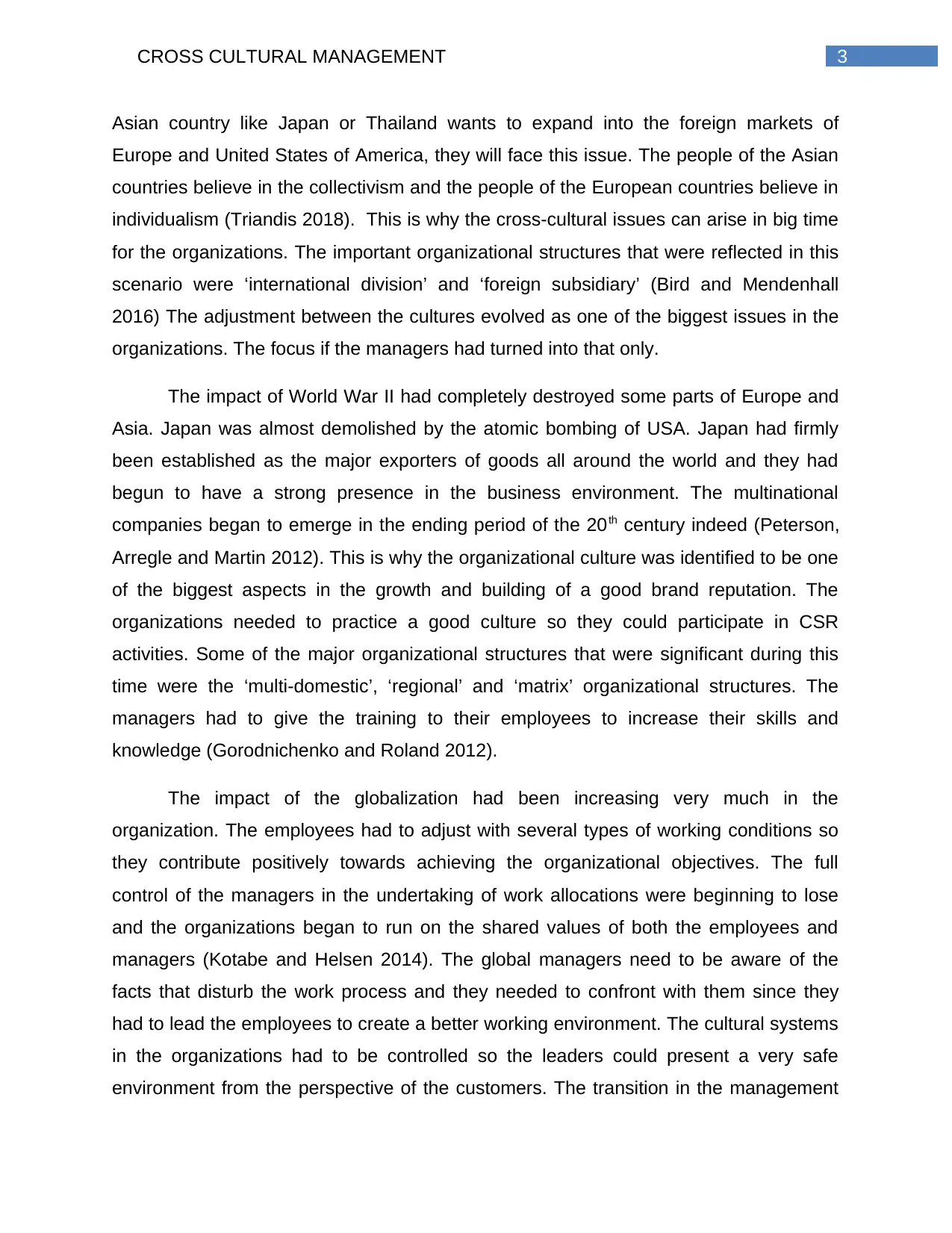
3CROSS CULTURAL MANAGEMENT
Asian country like Japan or Thailand wants to expand into the foreign markets of
Europe and United States of America, they will face this issue. The people of the Asian
countries believe in the collectivism and the people of the European countries believe in
individualism (Triandis 2018). This is why the cross-cultural issues can arise in big time
for the organizations. The important organizational structures that were reflected in this
scenario were ‘international division’ and ‘foreign subsidiary’ (Bird and Mendenhall
2016) The adjustment between the cultures evolved as one of the biggest issues in the
organizations. The focus if the managers had turned into that only.
The impact of World War II had completely destroyed some parts of Europe and
Asia. Japan was almost demolished by the atomic bombing of USA. Japan had firmly
been established as the major exporters of goods all around the world and they had
begun to have a strong presence in the business environment. The multinational
companies began to emerge in the ending period of the 20th century indeed (Peterson,
Arregle and Martin 2012). This is why the organizational culture was identified to be one
of the biggest aspects in the growth and building of a good brand reputation. The
organizations needed to practice a good culture so they could participate in CSR
activities. Some of the major organizational structures that were significant during this
time were the ‘multi-domestic’, ‘regional’ and ‘matrix’ organizational structures. The
managers had to give the training to their employees to increase their skills and
knowledge (Gorodnichenko and Roland 2012).
The impact of the globalization had been increasing very much in the
organization. The employees had to adjust with several types of working conditions so
they contribute positively towards achieving the organizational objectives. The full
control of the managers in the undertaking of work allocations were beginning to lose
and the organizations began to run on the shared values of both the employees and
managers (Kotabe and Helsen 2014). The global managers need to be aware of the
facts that disturb the work process and they needed to confront with them since they
had to lead the employees to create a better working environment. The cultural systems
in the organizations had to be controlled so the leaders could present a very safe
environment from the perspective of the customers. The transition in the management
Asian country like Japan or Thailand wants to expand into the foreign markets of
Europe and United States of America, they will face this issue. The people of the Asian
countries believe in the collectivism and the people of the European countries believe in
individualism (Triandis 2018). This is why the cross-cultural issues can arise in big time
for the organizations. The important organizational structures that were reflected in this
scenario were ‘international division’ and ‘foreign subsidiary’ (Bird and Mendenhall
2016) The adjustment between the cultures evolved as one of the biggest issues in the
organizations. The focus if the managers had turned into that only.
The impact of World War II had completely destroyed some parts of Europe and
Asia. Japan was almost demolished by the atomic bombing of USA. Japan had firmly
been established as the major exporters of goods all around the world and they had
begun to have a strong presence in the business environment. The multinational
companies began to emerge in the ending period of the 20th century indeed (Peterson,
Arregle and Martin 2012). This is why the organizational culture was identified to be one
of the biggest aspects in the growth and building of a good brand reputation. The
organizations needed to practice a good culture so they could participate in CSR
activities. Some of the major organizational structures that were significant during this
time were the ‘multi-domestic’, ‘regional’ and ‘matrix’ organizational structures. The
managers had to give the training to their employees to increase their skills and
knowledge (Gorodnichenko and Roland 2012).
The impact of the globalization had been increasing very much in the
organization. The employees had to adjust with several types of working conditions so
they contribute positively towards achieving the organizational objectives. The full
control of the managers in the undertaking of work allocations were beginning to lose
and the organizations began to run on the shared values of both the employees and
managers (Kotabe and Helsen 2014). The global managers need to be aware of the
facts that disturb the work process and they needed to confront with them since they
had to lead the employees to create a better working environment. The cultural systems
in the organizations had to be controlled so the leaders could present a very safe
environment from the perspective of the customers. The transition in the management
Paraphrase This Document
Need a fresh take? Get an instant paraphrase of this document with our AI Paraphraser
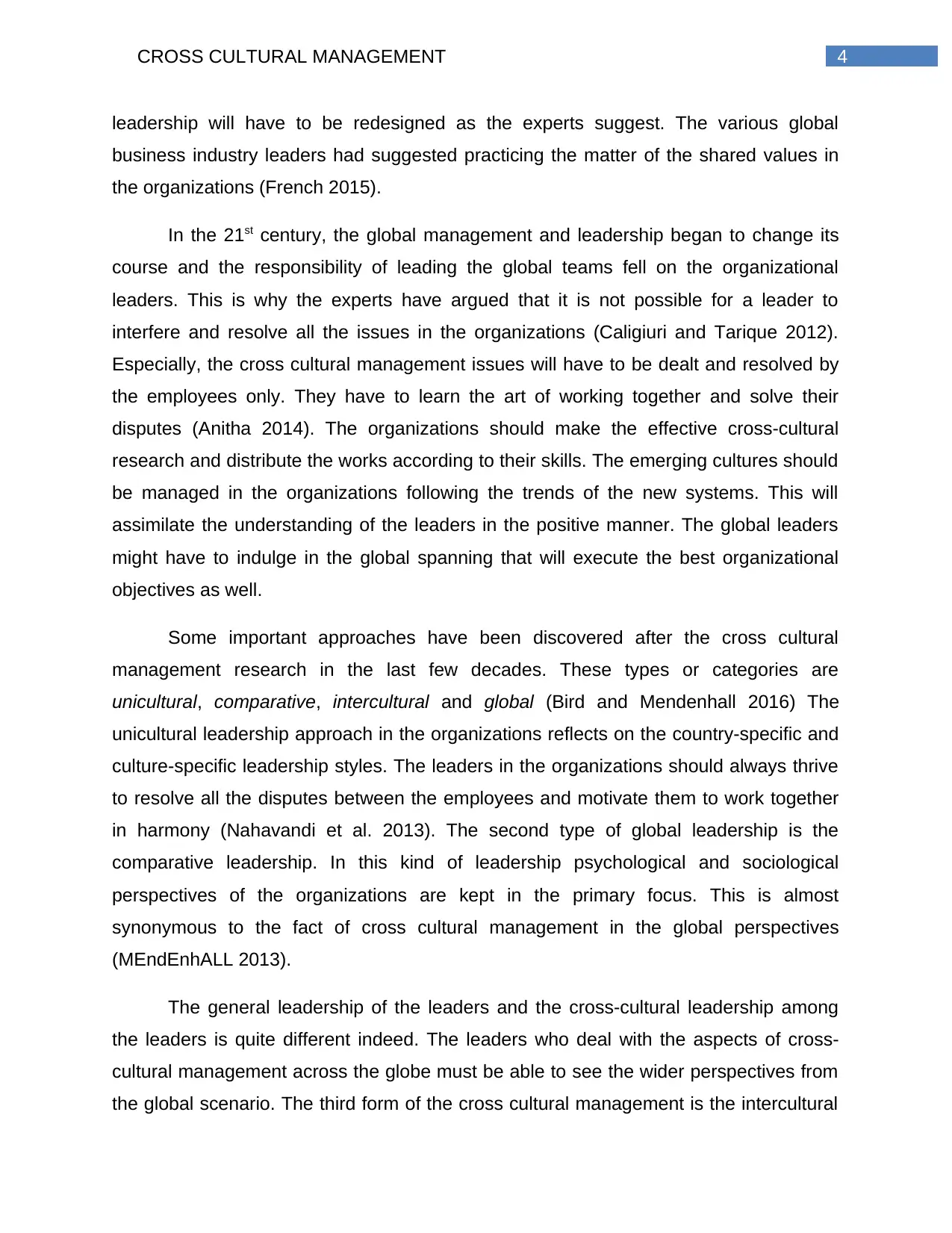
4CROSS CULTURAL MANAGEMENT
leadership will have to be redesigned as the experts suggest. The various global
business industry leaders had suggested practicing the matter of the shared values in
the organizations (French 2015).
In the 21st century, the global management and leadership began to change its
course and the responsibility of leading the global teams fell on the organizational
leaders. This is why the experts have argued that it is not possible for a leader to
interfere and resolve all the issues in the organizations (Caligiuri and Tarique 2012).
Especially, the cross cultural management issues will have to be dealt and resolved by
the employees only. They have to learn the art of working together and solve their
disputes (Anitha 2014). The organizations should make the effective cross-cultural
research and distribute the works according to their skills. The emerging cultures should
be managed in the organizations following the trends of the new systems. This will
assimilate the understanding of the leaders in the positive manner. The global leaders
might have to indulge in the global spanning that will execute the best organizational
objectives as well.
Some important approaches have been discovered after the cross cultural
management research in the last few decades. These types or categories are
unicultural, comparative, intercultural and global (Bird and Mendenhall 2016) The
unicultural leadership approach in the organizations reflects on the country-specific and
culture-specific leadership styles. The leaders in the organizations should always thrive
to resolve all the disputes between the employees and motivate them to work together
in harmony (Nahavandi et al. 2013). The second type of global leadership is the
comparative leadership. In this kind of leadership psychological and sociological
perspectives of the organizations are kept in the primary focus. This is almost
synonymous to the fact of cross cultural management in the global perspectives
(MEndEnhALL 2013).
The general leadership of the leaders and the cross-cultural leadership among
the leaders is quite different indeed. The leaders who deal with the aspects of cross-
cultural management across the globe must be able to see the wider perspectives from
the global scenario. The third form of the cross cultural management is the intercultural
leadership will have to be redesigned as the experts suggest. The various global
business industry leaders had suggested practicing the matter of the shared values in
the organizations (French 2015).
In the 21st century, the global management and leadership began to change its
course and the responsibility of leading the global teams fell on the organizational
leaders. This is why the experts have argued that it is not possible for a leader to
interfere and resolve all the issues in the organizations (Caligiuri and Tarique 2012).
Especially, the cross cultural management issues will have to be dealt and resolved by
the employees only. They have to learn the art of working together and solve their
disputes (Anitha 2014). The organizations should make the effective cross-cultural
research and distribute the works according to their skills. The emerging cultures should
be managed in the organizations following the trends of the new systems. This will
assimilate the understanding of the leaders in the positive manner. The global leaders
might have to indulge in the global spanning that will execute the best organizational
objectives as well.
Some important approaches have been discovered after the cross cultural
management research in the last few decades. These types or categories are
unicultural, comparative, intercultural and global (Bird and Mendenhall 2016) The
unicultural leadership approach in the organizations reflects on the country-specific and
culture-specific leadership styles. The leaders in the organizations should always thrive
to resolve all the disputes between the employees and motivate them to work together
in harmony (Nahavandi et al. 2013). The second type of global leadership is the
comparative leadership. In this kind of leadership psychological and sociological
perspectives of the organizations are kept in the primary focus. This is almost
synonymous to the fact of cross cultural management in the global perspectives
(MEndEnhALL 2013).
The general leadership of the leaders and the cross-cultural leadership among
the leaders is quite different indeed. The leaders who deal with the aspects of cross-
cultural management across the globe must be able to see the wider perspectives from
the global scenario. The third form of the cross cultural management is the intercultural
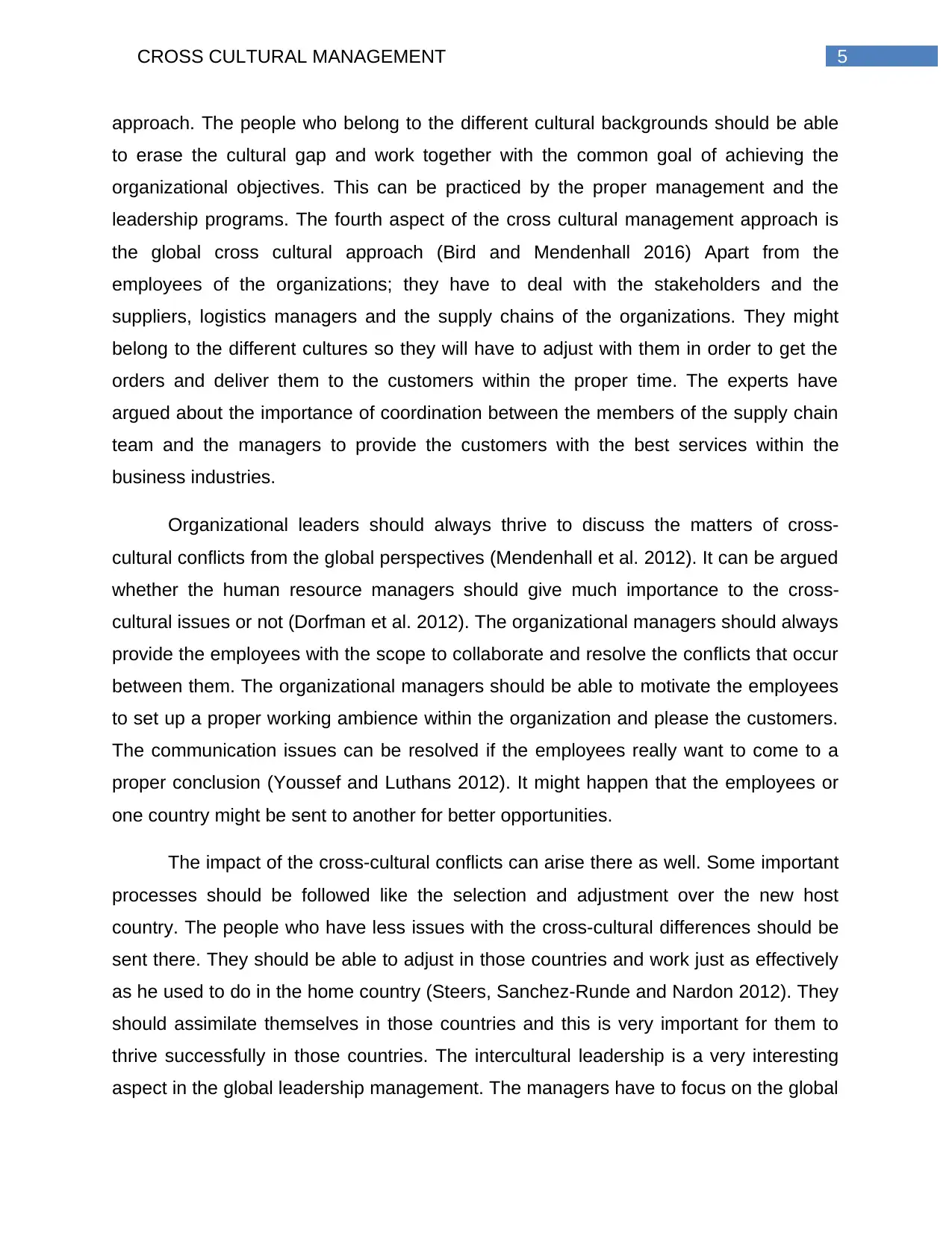
5CROSS CULTURAL MANAGEMENT
approach. The people who belong to the different cultural backgrounds should be able
to erase the cultural gap and work together with the common goal of achieving the
organizational objectives. This can be practiced by the proper management and the
leadership programs. The fourth aspect of the cross cultural management approach is
the global cross cultural approach (Bird and Mendenhall 2016) Apart from the
employees of the organizations; they have to deal with the stakeholders and the
suppliers, logistics managers and the supply chains of the organizations. They might
belong to the different cultures so they will have to adjust with them in order to get the
orders and deliver them to the customers within the proper time. The experts have
argued about the importance of coordination between the members of the supply chain
team and the managers to provide the customers with the best services within the
business industries.
Organizational leaders should always thrive to discuss the matters of cross-
cultural conflicts from the global perspectives (Mendenhall et al. 2012). It can be argued
whether the human resource managers should give much importance to the cross-
cultural issues or not (Dorfman et al. 2012). The organizational managers should always
provide the employees with the scope to collaborate and resolve the conflicts that occur
between them. The organizational managers should be able to motivate the employees
to set up a proper working ambience within the organization and please the customers.
The communication issues can be resolved if the employees really want to come to a
proper conclusion (Youssef and Luthans 2012). It might happen that the employees or
one country might be sent to another for better opportunities.
The impact of the cross-cultural conflicts can arise there as well. Some important
processes should be followed like the selection and adjustment over the new host
country. The people who have less issues with the cross-cultural differences should be
sent there. They should be able to adjust in those countries and work just as effectively
as he used to do in the home country (Steers, Sanchez-Runde and Nardon 2012). They
should assimilate themselves in those countries and this is very important for them to
thrive successfully in those countries. The intercultural leadership is a very interesting
aspect in the global leadership management. The managers have to focus on the global
approach. The people who belong to the different cultural backgrounds should be able
to erase the cultural gap and work together with the common goal of achieving the
organizational objectives. This can be practiced by the proper management and the
leadership programs. The fourth aspect of the cross cultural management approach is
the global cross cultural approach (Bird and Mendenhall 2016) Apart from the
employees of the organizations; they have to deal with the stakeholders and the
suppliers, logistics managers and the supply chains of the organizations. They might
belong to the different cultures so they will have to adjust with them in order to get the
orders and deliver them to the customers within the proper time. The experts have
argued about the importance of coordination between the members of the supply chain
team and the managers to provide the customers with the best services within the
business industries.
Organizational leaders should always thrive to discuss the matters of cross-
cultural conflicts from the global perspectives (Mendenhall et al. 2012). It can be argued
whether the human resource managers should give much importance to the cross-
cultural issues or not (Dorfman et al. 2012). The organizational managers should always
provide the employees with the scope to collaborate and resolve the conflicts that occur
between them. The organizational managers should be able to motivate the employees
to set up a proper working ambience within the organization and please the customers.
The communication issues can be resolved if the employees really want to come to a
proper conclusion (Youssef and Luthans 2012). It might happen that the employees or
one country might be sent to another for better opportunities.
The impact of the cross-cultural conflicts can arise there as well. Some important
processes should be followed like the selection and adjustment over the new host
country. The people who have less issues with the cross-cultural differences should be
sent there. They should be able to adjust in those countries and work just as effectively
as he used to do in the home country (Steers, Sanchez-Runde and Nardon 2012). They
should assimilate themselves in those countries and this is very important for them to
thrive successfully in those countries. The intercultural leadership is a very interesting
aspect in the global leadership management. The managers have to focus on the global
⊘ This is a preview!⊘
Do you want full access?
Subscribe today to unlock all pages.

Trusted by 1+ million students worldwide
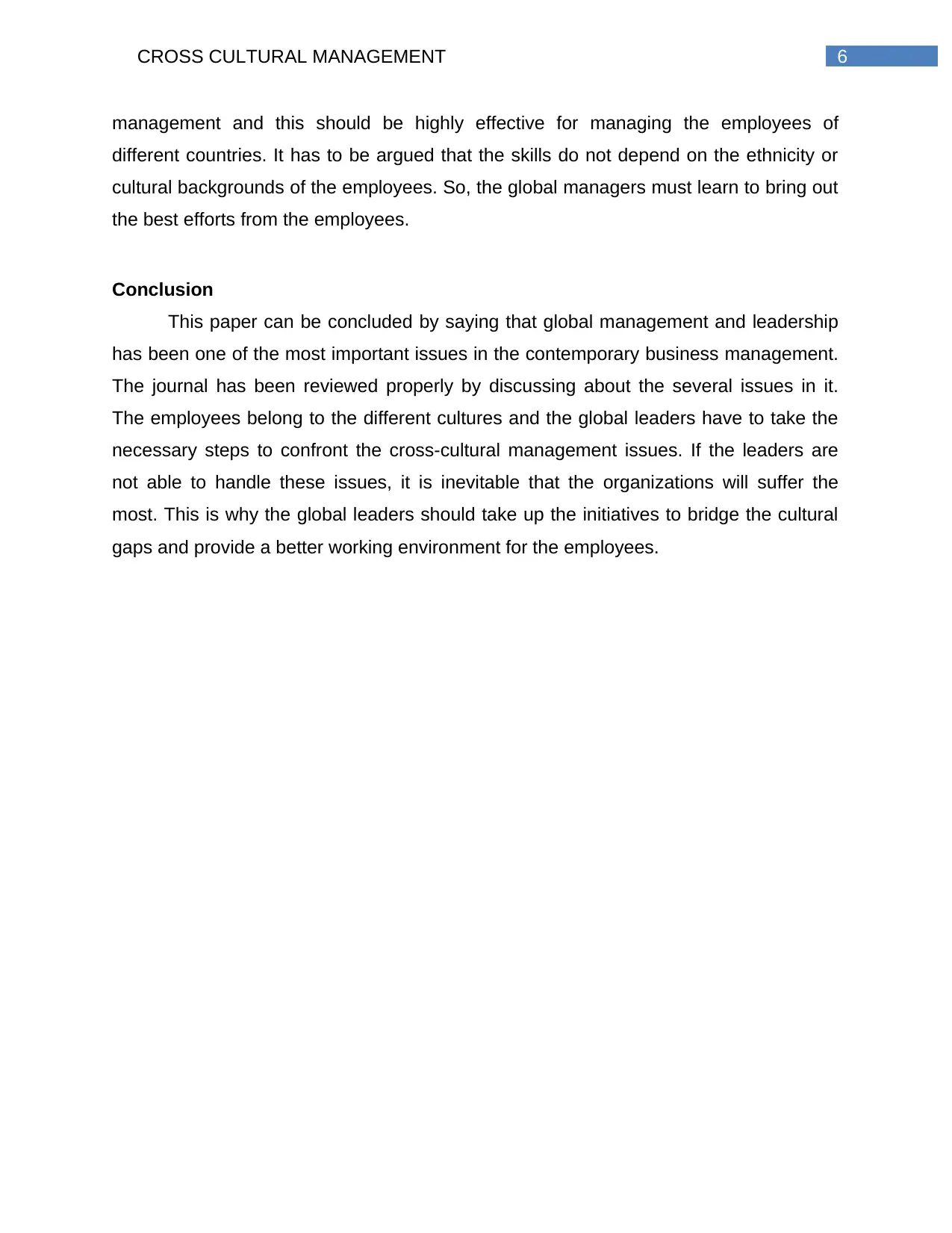
6CROSS CULTURAL MANAGEMENT
management and this should be highly effective for managing the employees of
different countries. It has to be argued that the skills do not depend on the ethnicity or
cultural backgrounds of the employees. So, the global managers must learn to bring out
the best efforts from the employees.
Conclusion
This paper can be concluded by saying that global management and leadership
has been one of the most important issues in the contemporary business management.
The journal has been reviewed properly by discussing about the several issues in it.
The employees belong to the different cultures and the global leaders have to take the
necessary steps to confront the cross-cultural management issues. If the leaders are
not able to handle these issues, it is inevitable that the organizations will suffer the
most. This is why the global leaders should take up the initiatives to bridge the cultural
gaps and provide a better working environment for the employees.
management and this should be highly effective for managing the employees of
different countries. It has to be argued that the skills do not depend on the ethnicity or
cultural backgrounds of the employees. So, the global managers must learn to bring out
the best efforts from the employees.
Conclusion
This paper can be concluded by saying that global management and leadership
has been one of the most important issues in the contemporary business management.
The journal has been reviewed properly by discussing about the several issues in it.
The employees belong to the different cultures and the global leaders have to take the
necessary steps to confront the cross-cultural management issues. If the leaders are
not able to handle these issues, it is inevitable that the organizations will suffer the
most. This is why the global leaders should take up the initiatives to bridge the cultural
gaps and provide a better working environment for the employees.
Paraphrase This Document
Need a fresh take? Get an instant paraphrase of this document with our AI Paraphraser
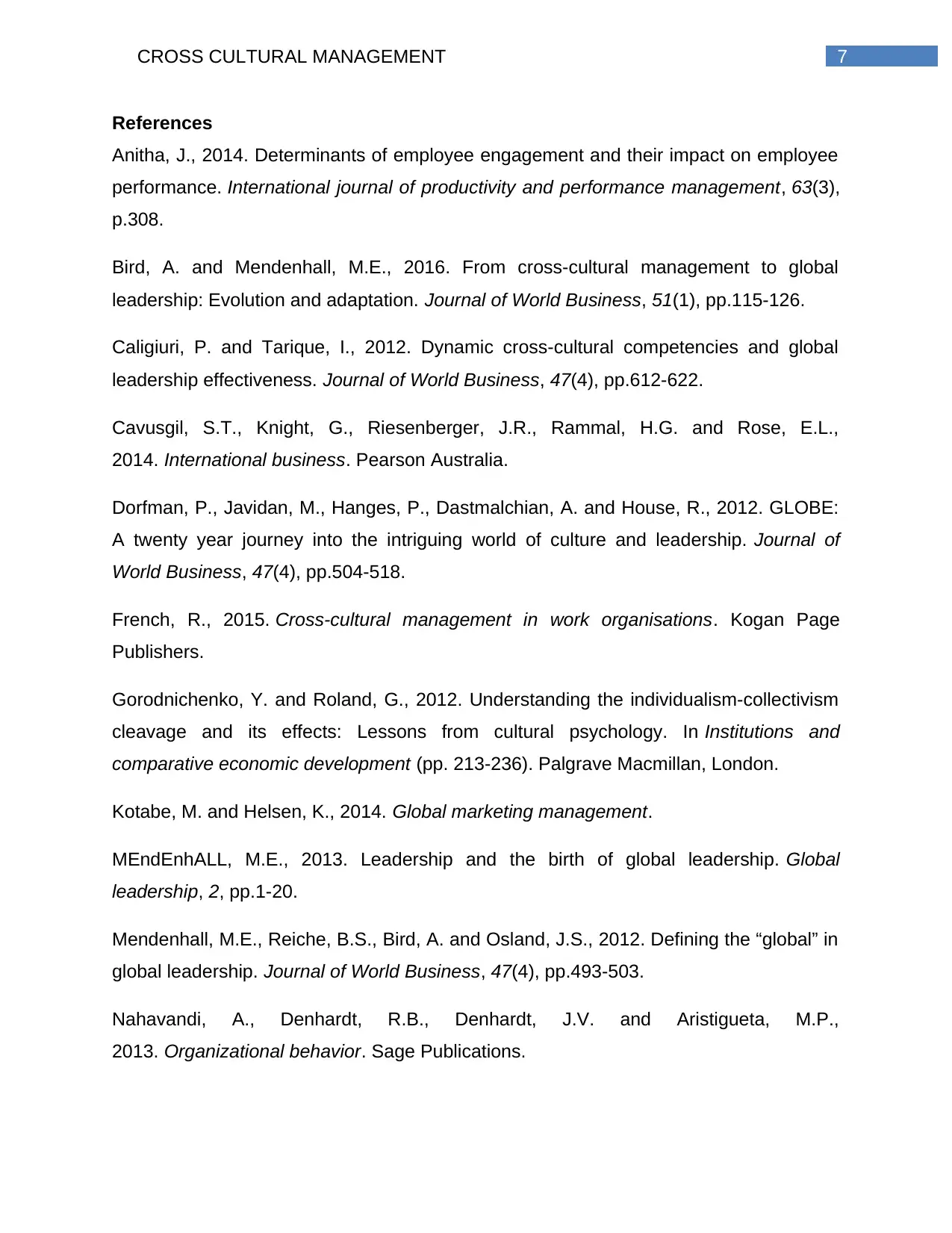
7CROSS CULTURAL MANAGEMENT
References
Anitha, J., 2014. Determinants of employee engagement and their impact on employee
performance. International journal of productivity and performance management, 63(3),
p.308.
Bird, A. and Mendenhall, M.E., 2016. From cross-cultural management to global
leadership: Evolution and adaptation. Journal of World Business, 51(1), pp.115-126.
Caligiuri, P. and Tarique, I., 2012. Dynamic cross-cultural competencies and global
leadership effectiveness. Journal of World Business, 47(4), pp.612-622.
Cavusgil, S.T., Knight, G., Riesenberger, J.R., Rammal, H.G. and Rose, E.L.,
2014. International business. Pearson Australia.
Dorfman, P., Javidan, M., Hanges, P., Dastmalchian, A. and House, R., 2012. GLOBE:
A twenty year journey into the intriguing world of culture and leadership. Journal of
World Business, 47(4), pp.504-518.
French, R., 2015. Cross-cultural management in work organisations. Kogan Page
Publishers.
Gorodnichenko, Y. and Roland, G., 2012. Understanding the individualism-collectivism
cleavage and its effects: Lessons from cultural psychology. In Institutions and
comparative economic development (pp. 213-236). Palgrave Macmillan, London.
Kotabe, M. and Helsen, K., 2014. Global marketing management.
MEndEnhALL, M.E., 2013. Leadership and the birth of global leadership. Global
leadership, 2, pp.1-20.
Mendenhall, M.E., Reiche, B.S., Bird, A. and Osland, J.S., 2012. Defining the “global” in
global leadership. Journal of World Business, 47(4), pp.493-503.
Nahavandi, A., Denhardt, R.B., Denhardt, J.V. and Aristigueta, M.P.,
2013. Organizational behavior. Sage Publications.
References
Anitha, J., 2014. Determinants of employee engagement and their impact on employee
performance. International journal of productivity and performance management, 63(3),
p.308.
Bird, A. and Mendenhall, M.E., 2016. From cross-cultural management to global
leadership: Evolution and adaptation. Journal of World Business, 51(1), pp.115-126.
Caligiuri, P. and Tarique, I., 2012. Dynamic cross-cultural competencies and global
leadership effectiveness. Journal of World Business, 47(4), pp.612-622.
Cavusgil, S.T., Knight, G., Riesenberger, J.R., Rammal, H.G. and Rose, E.L.,
2014. International business. Pearson Australia.
Dorfman, P., Javidan, M., Hanges, P., Dastmalchian, A. and House, R., 2012. GLOBE:
A twenty year journey into the intriguing world of culture and leadership. Journal of
World Business, 47(4), pp.504-518.
French, R., 2015. Cross-cultural management in work organisations. Kogan Page
Publishers.
Gorodnichenko, Y. and Roland, G., 2012. Understanding the individualism-collectivism
cleavage and its effects: Lessons from cultural psychology. In Institutions and
comparative economic development (pp. 213-236). Palgrave Macmillan, London.
Kotabe, M. and Helsen, K., 2014. Global marketing management.
MEndEnhALL, M.E., 2013. Leadership and the birth of global leadership. Global
leadership, 2, pp.1-20.
Mendenhall, M.E., Reiche, B.S., Bird, A. and Osland, J.S., 2012. Defining the “global” in
global leadership. Journal of World Business, 47(4), pp.493-503.
Nahavandi, A., Denhardt, R.B., Denhardt, J.V. and Aristigueta, M.P.,
2013. Organizational behavior. Sage Publications.
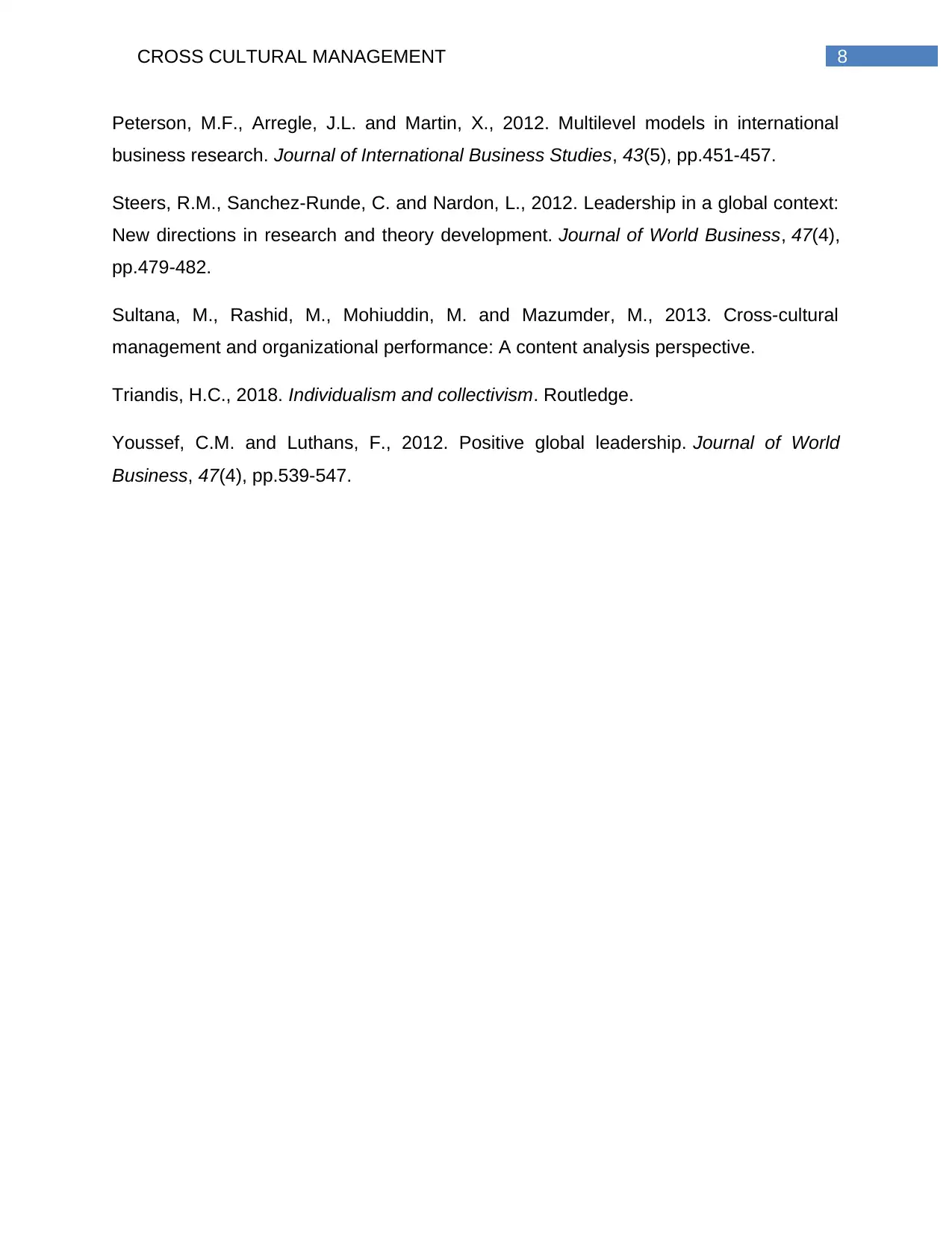
8CROSS CULTURAL MANAGEMENT
Peterson, M.F., Arregle, J.L. and Martin, X., 2012. Multilevel models in international
business research. Journal of International Business Studies, 43(5), pp.451-457.
Steers, R.M., Sanchez-Runde, C. and Nardon, L., 2012. Leadership in a global context:
New directions in research and theory development. Journal of World Business, 47(4),
pp.479-482.
Sultana, M., Rashid, M., Mohiuddin, M. and Mazumder, M., 2013. Cross-cultural
management and organizational performance: A content analysis perspective.
Triandis, H.C., 2018. Individualism and collectivism. Routledge.
Youssef, C.M. and Luthans, F., 2012. Positive global leadership. Journal of World
Business, 47(4), pp.539-547.
Peterson, M.F., Arregle, J.L. and Martin, X., 2012. Multilevel models in international
business research. Journal of International Business Studies, 43(5), pp.451-457.
Steers, R.M., Sanchez-Runde, C. and Nardon, L., 2012. Leadership in a global context:
New directions in research and theory development. Journal of World Business, 47(4),
pp.479-482.
Sultana, M., Rashid, M., Mohiuddin, M. and Mazumder, M., 2013. Cross-cultural
management and organizational performance: A content analysis perspective.
Triandis, H.C., 2018. Individualism and collectivism. Routledge.
Youssef, C.M. and Luthans, F., 2012. Positive global leadership. Journal of World
Business, 47(4), pp.539-547.
⊘ This is a preview!⊘
Do you want full access?
Subscribe today to unlock all pages.

Trusted by 1+ million students worldwide
1 out of 9
Related Documents
Your All-in-One AI-Powered Toolkit for Academic Success.
+13062052269
info@desklib.com
Available 24*7 on WhatsApp / Email
![[object Object]](/_next/static/media/star-bottom.7253800d.svg)
Unlock your academic potential
Copyright © 2020–2025 A2Z Services. All Rights Reserved. Developed and managed by ZUCOL.




